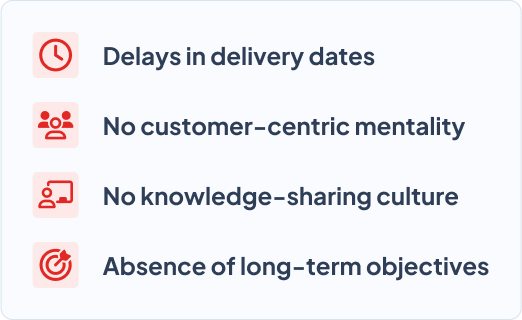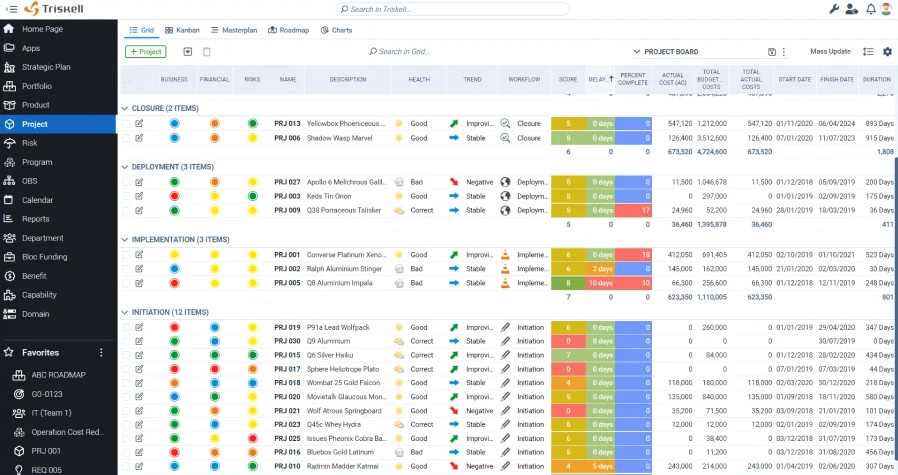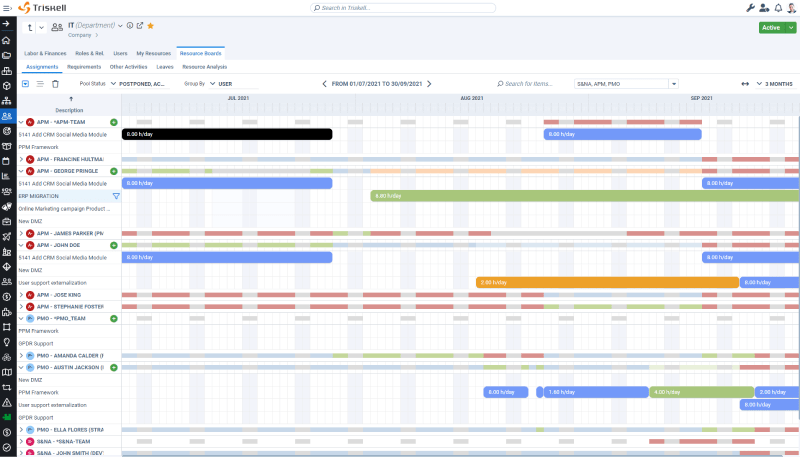How to break down silos in your organization: tips and best practices

How to break down silos in your company without dying in the attempt? You are not alone. You are not the only one working in an organization with a silo mentality. You are not the only Project Manager, PMO or IT manager frustrated because your deliverables and project deadlines get delayed. Or by experiencing day-to-day tense situations and misunderstandings with team leaders who prioritize their own interests before those of the organization.
And all because you belong to a business with totally isolated and disconnected work areas. Or, in other words, because silos are still in place in your company’s culture. Believe it or not, many organizations share the same problem, and this is the main reason why most fail to execute their project portfolio and align it with their strategic planning.
Are you going to stand idly by? Are you going to allow silos to compromise your organization’s competitiveness and objectives? We know you don’t, and that’s why we’re going to explain in detail how Triskell Software can help you break down organizational silos. Want to know how? Keep reading.
What are organizational silos?
Organizational silos occur when departments or teams within a company function with limited communication and collaboration. This isolation hinders information flow, reduces transparency, and can lead to inefficiencies, duplicated efforts, and missed opportunities.
Silos can arise due to various factors, such as:
- Departmental focus: teams become laser-focused on their own goals and metrics, losing sight of the bigger picture and how their work connects to other departments.
- Poor communication: lack of clear communication channels makes information sharing difficult, fostering a sense of isolation.
- Hierarchical structures: rigid hierarchies can create distance between teams, hindering collaboration and knowledge exchange.
- Competition: unhealthy competition between departments can lead to teams guarding information and resources jealously.
- Tech and tools: incompatible software and tools can make it difficult for teams to share data and collaborate seamlessly.
By understanding what silos are and their negative impact, companies can take proactive steps to break them down and foster a more collaborative work environment.
Breaking down silos, the major challenge for companies in their digital transformation
Digital transformation is a reality that all organizations are facing, whatever their sector or industry. It is a new highly competitive environment in which companies have to bring to market innovative and sophisticated products and services that satisfy the needs and expectations of increasingly demanding users and consumers as much as possible. And in the shortest possible time.
Organizations working in silos find it harder to compete
It is not difficult to conclude that, in this context, organizations working in silos find it more difficult to compete on equal terms with the rest. Regardless of the type of company or the sector in which it operates, all companies that work in silos have several elements in common:
1. Delays in the delivery dates
This is the most obvious consequence, and also the most critical considering the business context mentioned above. An organization with isolated departments and teams that look to their own self-interest rather than the common interest of the company will always fail to manage deadlines and resources across its portfolio of projects.
As a result, it will deliver late to the market products and services that have already been launched by competitors, or, as we will detail below, that are not adapted to users’ needs.
2. Work teams without a customer-centric mentality
Organizations working in silos have the bad habit of focusing only on their internal processes, isolated from the needs of the company and its customers. Sentences like “Here we have always done things this way” or “that task is not within our scope” are the ones that best define the teams that work in silos.
3. No knowledge sharing culture
Another consequence of working in a silo organization is that there are many internal sources of information and knowledge, but none of them are connected to each other. Each team protects its source of information as if it were a treasure, and there are no procedures for teams to share information with each other.
Are you familiar with the phrase “we work with these procedures and you work with yours”? That’s what we mean.
Absence of long-term objectives
Companies with silos, where each department looks only after its own interests, find it more difficult to design successful long-term strategic plans. This is mainly due to the lack of a customer-centric mentality in these types of organizations, whose processes and value streams are in many cases far from the demands of their target customers and markets.

Strategies to break down organizational silos
As you can see, the task of eliminating silos is not easy. This is a task that companies must undertake with a long-term vision, and should be led by top management. who must serve as agents of change and promote a new mindset whereby all teams work towards common goals.
Breaking down silos is a task to be undertaken in the long term
As this change of mindset takes place in the company at all levels, there are a number of decisions that companies can take in the short to medium term to make the challenge of breaking down organizational silos easier to accomplish. In summary, there are 5 strategies that can be developed in this context:
- Align strategy with portfolio execution.
- Standardization of processes and workflows.
- Transparency and constant communication channels.
- Efficient resource management.
- Unify project portfolio management and execution tools.
1. Align strategy with portfolio execution
The biggest challenge companies face today is to align their strategic planning with execution. A challenge that is even greater in those organizations with silos firmly established in their culture, since these teams are more concerned with their own concerns than with the success of the business.
The best way to put these silos to work towards achieving common objectives is for the organization to first define strategic objectives, and that these objectives are subsequently reflected into a project portfolio aligned with this planning. This is the only way to ensure that all teams understand that they have a level of responsibility for the success or failure of the company in meeting its objectives.
2. Standardization of processes and workflows
One of the main obstacles companies face in delivering products and services in the shortest possible time is the coexistence of different processes and workflows within each team, and that represents blocking points and bottlenecks to agile value delivery.
This is even more so in silo organizations, which are generally reluctant to implement processes and ways of working that are not their own and even less to share their procedures with others.
Organizations must define, list and prioritize all of their value streams
To put an end to this problem, companies must define all their value streams, list and prioritize them, and define standardized processes and workflows around them, to which all individuals and teams that, in one way or another, contribute to the delivery of value must adhere to them.
3. Transparency and constant communication channels
Emails with people in hidden copy, spreadsheets shared only within the team or lack of communication with stakeholders… These are quite common situations in organizations that work in silos. Teams hardly share information about the status and progress of their deliverables. And, when they do, it is to report to the management of the day, leaving this information vetoed for most of the stakeholders.
Management should encourage transparency in information sharing. Starting, in the first place, with the communication of the organization’s objectives to all levels of the organization. And then develop efficient communication channels and tools with which all the stakeholders can be informed of the status and progress of portfolio execution.
4. Efficient resource management
Resource management throughout the execution of the project portfolio is one of the most sensitive tasks for both Project and PMO managers, as it requires coordination with several departments and work areas. It is well known that in organizations that work in silos, environments that are not very receptive to the sharing of information, this is even more complex when it comes to requesting staff from these teams to execute projects, and so resource management becomes a real headache.
For efficient resource management in a siloed organization, it is essential that strategic planning and project portfolio execution are aligned. Only in this way, by having an overall view of the portfolio and the priorities, costs and risks of each project, team and project managers will be able to agree on the sharing of resources.
5. Unify project portfolio management and execution tools
One of the hallmarks of siloed organizations is the coexistence of several applications to manage different aspects of strategic planning and project portfolio execution.
It may happen that, while Excel is used to monitor and analyze the progress of each of the projects (being, in many cases, each project scattered in different databases), resource and time management is executed, for example, through Jira, while deliverables, incidents and demands are managed in other tools.
Managing the portfolio with many tools leads to the creation of silos
Working with many tools without any connection between them is also conducive to the creation of these silos. Therefore, organizations should consider reducing their suite of tools and centralize strategic planning and project and product portfolio management from a single point.
See the Triskell platform in action in a personal demo
How to break down silos with Triskell Software
Triskell Software is the All-in-One solution that will allow your organization to have a vision beyond the management, monitoring and analysis of your portfolio of projects and products. Its flexibility and many of the functionalities it includes will be your best support to break down organizational silos and align all teams towards the achievement of common goals.
What are these functionalities that will make it easier to break down silos in your company? They are the following:
- Portfolio planning and execution from a single interface.
- Linking deliverables and projects to strategic objectives.
- Visibility of the work of all teams.
- Configuration of processes and workflows.
- Kanban, Masterplan and Grid views for better clarity.
- Centralized information in a single system.
- Real-time alerts and notifications system.
Portfolio planning and execution from a single interface
Triskell has features that make it more than just another PPM software on the market. It provides a complete view of the organization’s project portfolio, facilitating decision-making on issues such as financial and resource management, or the prioritization of projects according to the value they will bring to the organization.
Working with many tools without any connection between them is also conducive to the creation of these silos. Therefore, organizations should consider reducing their suite of tools and centralize strategic planning and project and product portfolio management from a single point.

All teams will have a real-time, up-to-date view of the status of their projects. From Triskell’s interface, you can plan, manage, monitor and analyze the organization’s portfolio, being your best ally for better decision making on the projects you have underway.
Linking deliverables and projects to strategic objectives
Thanks to our solution you will be able to align each of your team’s initiatives and projects to the strategic objectives of the organization. With Triskell you will be able to define and prioritize strategic objectives for your company, and each of the objects you create in our interface (projects, products, deliverables) can be linked to one of these objectives.
With this functionality, departments that are used to working in silos will see how their work adds value to the organization. This will help create a corporate work culture that fosters collaboration, communication and transparency.
Visibility of the work of all teams
As you may already know, teams working in silos often operate disconnected from the organization’s strategic planning and objectives. They tend to focus exclusively on executing their projects and tasks on time and on budget, without considering the value they are providing or the priority of what they are doing within the organization’s project portfolio.
Teams working in silos are disconnected from the strategic objectives of the organization

With Triskell you will have full visibility of the status of the tasks being carried out by all the departments in your organization thanks to the wide range of possibilities it offers when integrating it with other applications such as the following:
- Jira: with this integration, you will be able to connect project portfolio planning and management with its execution. You will have direct visibility with the tasks carried out by the development and IT teams of your organization.
- Triskell has the option to integrate with other more classic solutions for project management, such as Microsoft Project, Excel and even Sharepoint. This way, you will have full control of the status of all your projects.
- In addition, with Triskell’s API, you can connect its interface with any other solution that the company has developed internally. This will increase transparency and collaboration between different areas and eliminate silos.
Configuration of processes and workflows
Process and workflow design is one of the most bureaucratic parts of project portfolio management. Even more so in a siloed company structure, where each work team has its own procedures and ways of working.
Triskell facilitates this task by allowing you to design processes and workflows in a simple and intuitive way for your project portfolio. In this way, teams and stakeholders will work with the same rules, and those teams working in silos will have to get out of their bubble and adhere to the processes you have established in our solution.
Kanban, Masterplan and Grid views for better clarity
In the same organization, especially if there are teams working in silos, there may be departments that work following Agile methodologies and others that follow more traditional approaches. This fact makes project portfolio management more challenging if you don’t have clear reports or views for teams to understand the status of their projects.
Triskell Software has Kanban, Masterplan and Grid views in its interface, which help to facilitate the understanding of the data that make up your project portfolio. All these views are customizable, with a wide range of filters, so that each stakeholder can see the information that really interests them.
Centralized information in a single system
No more having 4 or 5 different tools to manage, monitor and analyze the project or product portfolio. Triskell Software has different solutions with which you will be able to perform all the tasks of the project portfolio from a single interface.
Triskell will allow you to perform all project portfolio tasks from a single interface
Resource allocation, risk and cost management, budgeting, demand management, customized reports and dashboards… All this and more can be easily and flexibly configured in Triskell Software’s PPM solution.
Real-time alerts and notifications system
We have already explained that in order to eliminate silos, it is essential to promote transparency and collaboration and communication between teams and individuals at all levels of the organization. Triskell Software has features such as a system of real-time alerts and notifications, as well as a wide range of fully customizable dashboards and reports, that will allow you to move your teams towards a culture based on teamwork and information sharing.
Subscribe to our Newsletter
Get stories like this in your inbox
Do you want to make silos in your company a thing of the past?
Do you want to lead change in your organization and break down the departmental silos that are causing you so many headaches? Discover how our solution can help you drive the change.

FAQs about breaking down silos
Besides communication, what are other benefits of breaking down silos?
Improved communication is a key advantage, but breaking down silos offers a wider range of benefits. These include:
- Increased efficiency: When teams collaborate and share information, they can avoid duplication of effort and streamline processes.
- Better resource allocation: With a clear view of everyone’s workload and priorities, resources can be allocated more effectively across the organization.
- Improved problem-solving: By sharing knowledge and perspectives, teams can tackle complex problems more effectively.
- Enhanced innovation: Collaboration fosters a more creative environment where ideas can be shared and developed more readily.
Can silos be broken down without any software?
Absolutely! Breaking down silos is ultimately about fostering a culture of collaboration and transparency. However, PPM tools like Triskell Software can significantly enhance these efforts.
How can Triskell Software help with breaking down silos in my company?
Triskell Software offers several features that promote collaboration and break down silos:
- Unified platform: A central platform streamlines communication and information sharing across teams.
- Visibility and transparency: Everyone has access to real-time project data, fostering a sense of shared purpose.
- Workflow management: Standardized workflows ensure consistent processes and clear handoffs between teams.
- Real-time alerts and notifications: Keep everyone informed about important updates and deadlines.
By promoting collaboration and transparency, Triskell Software empowers teams to work together more effectively, ultimately breaking down silos within your organization.
Related Content

Why the CIO needs a PMO approach
Unlock business success: discover why the CIO must embrace a PMO approach! to elevate efficiency and boost productivity.

Lean Budgeting for Agile Portfolios: A Comprehensive Guide
Lean Budgeting: the financial revolution for Agile portfolios. Discover how to streamline project financing and optimize value delivery.

Implementing SAFe with a 7-step roadmap
Do you want to scale Agile at the enterprise level and don’t know where to start? We solve your doubts by explaining the steps to implement SAFe.

